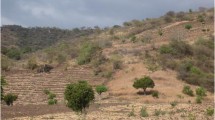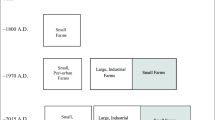Abstract
Sustainable intensification is a process designed to achieve higher agricultural yields whilst simultaneously reducing the negative impact of farming on the environment. It is an idea that has had much prominence over the last decade, but which has also raised considerable concerns among a number of different stakeholders. In particular, there are worries that it might be used to justify intensification per se and the accelerated adoption of particular forms of high-input and hi-tech agriculture. Here, some of the issues surrounding the concept of sustainable intensification are explored including: how the term itself has become a centre of debate, how it has been appropriated to support different worldviews, and how it might evolve to help the food system respond to the environmental and food security challenges ahead.
Similar content being viewed by others
References
Aksoy, A., & Beghin, J. C. (Eds.). (2005). Global agricultural trade and developing countries. Washington DC: The World Bank.
Alcott, B. (2005). Jevons’ paradox. Ecological Economics, 54, 9–21.
Baldos, U. L. C., & Hertel, T. W. (2014). Bursting the bubble: A long run perspective on crop commodity prices. GTAP Working Paper, 80.
Bongaarts, J. (2009). Human population growth and the demographic transition. Philosophical Transactions of the Royal Society B-Biological Sciences, 364(1532), 2985–2990. doi:10.1098/rstb.2009.0137.
Burney, J. A., Davis, S. J., & Lobell, D. B. (2010). Greenhouse gas mitigation by agricultural intensification. Proceedings of the National Academy of Sciences of the United States of America, 107(26), 12052–12057.
Cassman, K. G. (1999). Ecological intensification of cereal production systems: yield potential, soil quality, and precision agriculture. Proceedings of the National Academy of Sciences of the United States of America, 96(11), 5952–5959.
Challinor, A. J., Watson, J., Lobell, D. B., Howden, S. M., Smith, D. R., & Chhetri, N. (2014). A meta-analysis of crop yield under climate change and adaptation. Nature Climate Change, 4(4), 287–291. doi:10.1038/Nclimate2153.
CIWF. (2012). Sustainable intensification: An oxymoron. Godalming: Compassion in World Farming.
Collier, P. (2011). The plundered planet. Oxford: Oxford University Press.
Collins, E. D., & Chandrasekaran, K. (2012). A wolf in sheep’s clothing? An analysis of the ‘sustainable intensification’ of agriculture. Amsterdam: Friends of the Earth International.
Conway, G. (2012). One billion hungry, can we feed the world? Ithaca: Cornell University Press.
Dawkins, M. S. (2011). Why animals matter. Oxford: Oxford University Press.
de Schutter, O. (2011). Agroecology and the Right to Food, Report presented at the 16th Session of the United Nations Human Rights Council, 8 March 2011. New York: United Nations.
Drewnowski, A., & Popkin, B. M. (1997). The nutrition transition: new trends in the global diet. Nutrition Reviews, 55(2), 31–43.
Ezeh, A. C., Bongaarts, J., & Mberu, B. (2012). Global population trends and policy options. Lancet, 380(9837), 142–148. doi:10.1016/S0140-6736(12)60696-5.
FAO. (2011). Save and grow; A policymaker’s guide to the sustainable intensification of smallholder crop production. Rome: FAO.
FAO. (2012). The state of food insecurity in the world. Rome: FAO.
Foley, J. A., Ramankutty, N., Brauman, K. A., Cassidy, E. S., Gerber, J. S., Johnston, M., et al. (2011). Solutions for a cultivated planet. Nature, 478(7369), 337–342. doi:10.1038/Nature10452.
Foresight. (2011). The future of food and farming. London: Government Office for Science.
Friel, S., Dangour, A. D., Garnett, T., Lock, K., Chalabi, Z., Roberts, I., et al. (2009). Health and climate change: four public health benefits of strategies to reduce greenhouse-gas emissions: food and agriculture. Lancet, 374(9706), 2016–2025. doi:10.1016/S0140-6736(09)61753-0.
Garnett, T., Appleby, M. C., Balmford, A., Bateman, I. J., Benton, T. G., Bloomer, P., et al. (2013). Sustainable intensification in agriculture: premises and policies. Science, 341(6141), 33–34. doi:10.1126/Science.1234485.
Godfray, H. C. J., & Garnett, T. (2014). Food security and sustainable intensification. Philosophical Transactions of the Royal Society B-Biological Sciences, 369, 20120273.
Godfray, H. C. J., Beddington, J. R., Crute, I. R., Haddad, L., Lawrence, D., Muir, J. F., et al. (2010). Food security: the challenge of feeding 9 billion people. Science, 327(5967), 812–818.
Gornall, J., Betts, R., Burke, E., Clark, R., Camp, J., Willett, K., et al. (2010). Implications of climate change for agricultural productivity in the early twenty-first century. Philosophical Transactions of the Royal Society B-Biological Sciences, 365(1554), 2973–2989.
Gustavsson, J., Cederberg, C., Sonesson, U., van Otterdijk, R., & Meybeck, A. (2011). Global food losses and food waste. Rome: FAO.
Harrigan, J. (2014). The political economy of Arab food sovereignty. London: Palgrave Macmillan.
Hawkes, C., & Ruel, M. T. (2006). Understanding the links between agriculture and health. Washington: IFPRI.
Hawkesworth, S., Dangour, A., Johnston, D., Lock, K., Poole, N., Rushton, J., et al. (2010). Feeding the world healthily: the challenge of measuring the effects of agriculture on health. Philosophical Transactions of the Royal Society B-Biological Sciences, 365, 3083–3097.
HLPE. (2014). Food losses and waste in the context of sustainable food systems. Rome: High Level Panel of Experts on Food Security and Nutrition of the Committee on World Food Security.
Hodgson, J. A., Kunin, W. E., Thomas, C. D., Benton, T. G., & Gabriel, D. (2010). Comparing organic farming and land sparing: optimizing yield and butterfly populations at a landscape scale. [Letter]. Ecology Letters, 13(11), 1358–1367. doi:10.1111/j.1461-0248.2010.01528.x.
IAASTD. (2008). International assessment of agricultural knowledge, science and technology for development: Executive summary of the synthesis report. New York: IAASTD.
Kershen, K. L. (2013). The contested vision for agriculture’s future: sustainable intensive agriculture and agroecology. Creighton Law Review, 46, 591–618.
Lagi, M., Bertrand, K. Z., & Bar-Yam, Y. (2011). The food crises and politiucal insatability in North Africa and the Middle East. arXiv, 1108.2455 (August 10, 2011).
Ludena, C. E., Hertel, T. W., Preckel, P. V., Foster, K., & Nin, A. (2007). Productivity growth and convergence in crop, ruminant, and nonruminant production: measurement and forecasts. Agricultural Economics, 37(1), 1–17. doi:10.1111/J.1574-0862.2007.00218.X.
Lutz, W., & Samir, K. C. (2010). Dimensions of global population projections: what do we know about future population trends and structures? Philosophical Transactions of the Royal Society B-Biological Sciences, 365(1554), 2779–2791.
Nellemann, C., MacDevette, M., Manders, T., Eickhout, B., Svihus, B., Prins, A. G., et al. (Eds.) (2009). The enviromental food crisis: UNEP.
Nelson, G. C. (2014). Advancing global food security in the face of climate change. Chicago: The Chicago Council on Global Affairs.
Nelson, G. C., Rosegrant, M. W., Palazzo, A., Gray, I., Ingersoll, C., Robertson, R., et al. (2010). Food security & climate change, challeges to 2050. Washington: IFPRI.
Nelson, G. C., Valin, H., Sands, R. D., Havlik, P., Ahammad, H., Deryng, D., et al. (2014). Climate change effects on agriculture: economic responses to biophysical shocks. Proceedings of the National Academy of Sciences of the United States of America, 111(9), 3274–3279. doi:10.1073/Pnas.1222465110.
Norris, K., Asase, A., Collen, B., Gockowksi, J., Mason, J., Phalan, B., et al. (2010). Biodiversity in a forest-agriculture mosaic - the changing face of West African rainforests. Biological Conservation, 143(10), 2341–2350. doi:10.1016/j.biocon.2009.12.032.
Paillard, S., Treyer, S., & Dorin, B. (2009). Agrimonde: Scenarios and challenges for feeding the world in 2050. Versailles: Quae.
Phalan, B., Balmford, A., Green, R. E., & Scharlemann, J. P. W. (2011a). Minimising the harm to biodiversity of producing more food globally. Food Policy, 36, S62–S71. doi:10.1016/j.foodpol.2010.11.008.
Phalan, B., Onial, M., Balmford, A., & Green, R. E. (2011b). Reconciling food production and biodiversity conservation: land sharing and land sparing compared. Science, 333(6047), 1289–1291. doi:10.1126/science.1208742.
Piesse, J., & Thirtle, C. (2009). Three bubbles and a panic: an explanatory review of recent food commodity price events. Food Policy, 34(2), 119–129. doi:10.1016/j.foodpol.2009.01.001.
Piesse, J., & Thirtle, C. (2010). Agricultural R&D, technology and productivity. Philosophical Transactions of the Royal Society B-Biological Sciences, 365(1554), 3035–3047.
Popkin, B. M. (1998). The nutrition transition and its health implications in lower-income countries. Public Health Nutrition, 1, 5–21.
Pretty, J. (2008). Agricultural sustainability: concepts, principles and evidence. Philosophical Transactions of the Royal Society B-Biological Sciences, 363(1491), 447–465. doi:10.1098/rstb.2007.2163.
Pretty, J., Toulmin, C., & Williams, S. (2011). Sustainable intensification in African agriculture. International Journal of Agricultural Sustainability, 9(1), 5–24. doi:10.3763/Ijas.2010.0583.
Ray, D. K., Mueller, N. D., West, P. C., & Foley, J. A. (2013). Yield trends are insufficient to double global crop production by 2050. PLoS ONE, 8(6), doi: 10.1371/journal.pone.0066428.
Royal Society. (2009). Reaping the benefits: Science and the sustainable intensification of global agriculture. London: Royal Society.
Sandel, M. (2012). What money can’t buy: The moral limits of markets. New York: Farrar, Straus and Giroux.
Satterthwaite, D., McGranahan, G., & Tacoli, C. (2010). Urbanization and its implications for food and farming. Philosophical Transactions of the Royal Society B-Biological Sciences, 365(1554), 2809–2820. doi:10.1098/rstb.2010.0136.
Schmidhuber, J., & Tubiello, F. N. (2007). Global food security under climate change. Proceedings of the National Academy of Sciences of the United States of America, 104(50), 19703–19708. doi:10.1073/pnas.0701976104.
Searchinger, T. D. (2014). Creating a sustainable food future: A menu of solutions to sustainably feed more than 9 billion people by 2050 (Interim Report). Washington DC: World Resources Institute.
Sen, A. (1981). Poverty and famines. Oxford: Oxford University Press.
Seufert, V., Ramankutty, N., & Foley, J. A. (2012). Comparing the yields of organic and conventional agriculture. Nature, 485(7397), 229–U113. doi:10.1038/Nature11069.
Soil Association. (2010). Telling Porkies: the big fat lie about doubling food production. Bristol: Soil Association.
Stern, N. (2007). The economics of climate change. Cambridge: Cambridge University Press.
Strzepek, K., & Boehlert, B. (2010). Competition for water for the food system. Philosophical Transactions of the Royal Society B-Biological Sciences, 365(1554), 2927–2940.
TEEB (Ed.) (2011). The economics of ecosystems and biodiversity for national and international policy makers. London: Routlidge.
Tilman, D., Balzer, C., Hill, J., & Befort, B. L. (2011). Global food demand and the sustainable intensification of agriculture. [Article]. Proceedings of the National Academy of Sciences of the United States of America, 108(50), 20260–20264. doi:10.1073/pnas.1116437108.
United Nations. (2011). World population prospects, the 2010 revision. New York: United Nations, Department of Economic and Social Affairs, Population Division.
United Nations. (2013). World population prospects, the 2012 revision. New York: United Nations, Department of Economic and Social Affairs, Population Division.
Wheeler, T., & von Braun, J. (2013). Climate change impacts on global food security. Science, 341(6145), 508–513. doi:10.1126/Science.1239402.
WRAP. (2008). The food we waste. Banbury: Waste and resources action programme.
Acknowledgments
I am grateful to John Beddington, Ian Crute, Gordon Conway, Tara Garnett, Lawrence Haddad, the late Jim Muir, Jules Pretty, Sherman Robinson and Camilla Toulmin for valuable discussion. This paper was part of a workshop sponsored by the OECD Co-operative Research Programme on Biological Resource Management for Sustainable Agricultural Systems.
Author information
Authors and Affiliations
Corresponding author
Rights and permissions
About this article
Cite this article
Godfray, H.C.J. The debate over sustainable intensification. Food Sec. 7, 199–208 (2015). https://doi.org/10.1007/s12571-015-0424-2
Received:
Accepted:
Published:
Issue Date:
DOI: https://doi.org/10.1007/s12571-015-0424-2




